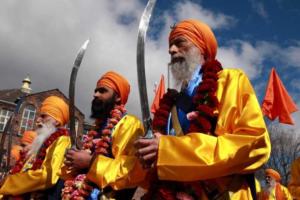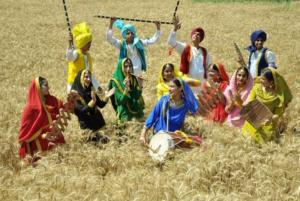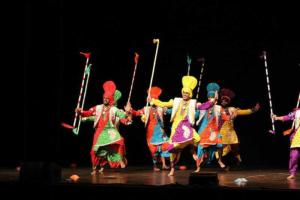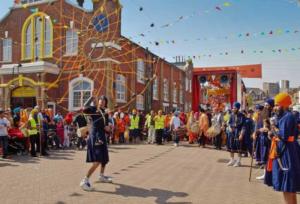Sorry, nothing in cart.
Festival of Vaisakhi in Punjab
Baisakhi or Vaisakhi Festival is celebrated as the Sikh New Year and the founding of the Khalsa Panth. History of Baisakhi traces its origin from the Baisakhi Day celebrations of 1699 organized by the Tenth Sikh Guru, Guru Gobind Singh to form Khalsa – Brotherhood of Saint Soldiers to fight against tyranny and oppression.
Dates of Vaisakhi
Religious and Historical Significance of Baisakhi
 Baisakhi was one of the three festivals that the third Sikh Guru, Guru Amar Das, chose to be celebrated by the Sikhs. In 1699, the ninth Sikh Guru, Guru Teg Bahadur, was publicly beheaded by the Mughals. This occurred due to his willingness to oppose the Mughal invaders and protect the cultural identity of Hindus and Sikhs whom the Mughal ruler Aurangzeb wanted to convert to Islam. On Baisakhi day of 1699, his son, Guru Gobind Rai, rallied the Sikhs and inspired them through his words and actions, bestowing upon them and himself the title of Singh or lion, thus becoming Guru Gobind Singh. The five Ks of Sikhism were adopted, and the Guru system was dispelled, with Sikhs being urged to accept the Granth Sahib as the eternal guide. Thus, the festival of Baisakhi is observed as the coronation of the last Sikh Guru, Guru Gobind Singh, as well as the foundation of the Khalsa Panth of Sikhism, granting it a position of immense importance to Sikhism, and is one of the biggest Sikh festivals.
Baisakhi was one of the three festivals that the third Sikh Guru, Guru Amar Das, chose to be celebrated by the Sikhs. In 1699, the ninth Sikh Guru, Guru Teg Bahadur, was publicly beheaded by the Mughals. This occurred due to his willingness to oppose the Mughal invaders and protect the cultural identity of Hindus and Sikhs whom the Mughal ruler Aurangzeb wanted to convert to Islam. On Baisakhi day of 1699, his son, Guru Gobind Rai, rallied the Sikhs and inspired them through his words and actions, bestowing upon them and himself the title of Singh or lion, thus becoming Guru Gobind Singh. The five Ks of Sikhism were adopted, and the Guru system was dispelled, with Sikhs being urged to accept the Granth Sahib as the eternal guide. Thus, the festival of Baisakhi is observed as the coronation of the last Sikh Guru, Guru Gobind Singh, as well as the foundation of the Khalsa Panth of Sikhism, granting it a position of immense importance to Sikhism, and is one of the biggest Sikh festivals.Baisakhi was also the day of the Jallianwala Bagh Massacre in 1919, when the British colonists trapped and murdered a peaceful assembly of Indians, acting as a major catalyst in the Indian freedom struggle.
Baisakhi Celebrations in Punjab
The Sikhs celebrate Baisakhi by bathing in the holy river and visiting the Gurudwaras, where they take part in the prayers held during the day. Baisakhi gets everyone into the festive mood, and people like to dance their heart out. Special celebrations occur at the Talwandi Sabo, where Guru Gobind Singh recompiled the sacred Granth Sahib, the Gurudwara at Anandpur Sahib, where Khalsa was born, and the Golden Temple in Amritsar. Farmers thank God for the bountiful harvest and pray for prosperity in the coming year. The phrase ‘Jatta Aayi Baisakhi’ is loudly declared across the fields by gleeful farmers as they passionately dance in celebration, an exciting way of greeting the festival.
Clothes
 As a celebration of the new spring, Vaisakhi is an occasion which sees men, women and children commemorate this joyous occasion by buying new attire, picking the most lively and dynamic of the lot to reflect the atmosphere of happiness felt throughout the crowd. Traditional Punjabi attire for men includes the turban with the fan-like adornment worn with a kurta, a waistcoat, the rummal or scarf, and the lungi tied around their waist, while the women wear the customary garments of Salwar Kameez with the most festive and ostentatious jewellery. The multi-coloured brilliance of this attire reflects the perky and bubbly nature of the Punjabi way of living.
As a celebration of the new spring, Vaisakhi is an occasion which sees men, women and children commemorate this joyous occasion by buying new attire, picking the most lively and dynamic of the lot to reflect the atmosphere of happiness felt throughout the crowd. Traditional Punjabi attire for men includes the turban with the fan-like adornment worn with a kurta, a waistcoat, the rummal or scarf, and the lungi tied around their waist, while the women wear the customary garments of Salwar Kameez with the most festive and ostentatious jewellery. The multi-coloured brilliance of this attire reflects the perky and bubbly nature of the Punjabi way of living.Dances Performed During Baisakhi
 The traditional dances of Bhangra and Gidda are performed to the beat of the drums in open fields creating an atmosphere of zest and joy. At some places, fairs are held where people bring out their happiness and perform bhangra, gidda and acrobatics. Men, women and children adorn themselves in colourful clothes and jewellery while they excitedly participate in the festivities.
The traditional dances of Bhangra and Gidda are performed to the beat of the drums in open fields creating an atmosphere of zest and joy. At some places, fairs are held where people bring out their happiness and perform bhangra, gidda and acrobatics. Men, women and children adorn themselves in colourful clothes and jewellery while they excitedly participate in the festivities.Food
Processions
 The Baisakhi Procession, also known as Nagar Kirtan, is an important part of the celebrations in Punjab. The most sacred scripture Granth Sahib is taken out with honour by traditionally dressed Panj Piaras, also known as the five senior religious Sikhs, and an important part of the Khals traditions. Baisakhi processions move through the streets and lanes of the city, accompanied by music, singing and chanting of scriptures and hymns. A large number of devotees participate in the Baisakhi processions.
The Baisakhi Procession, also known as Nagar Kirtan, is an important part of the celebrations in Punjab. The most sacred scripture Granth Sahib is taken out with honour by traditionally dressed Panj Piaras, also known as the five senior religious Sikhs, and an important part of the Khals traditions. Baisakhi processions move through the streets and lanes of the city, accompanied by music, singing and chanting of scriptures and hymns. A large number of devotees participate in the Baisakhi processions.


 WhatsApp us
WhatsApp us
Leave a Reply
You must be logged in to post a comment.